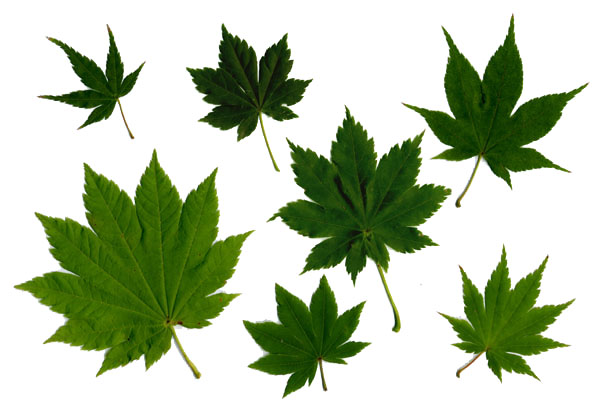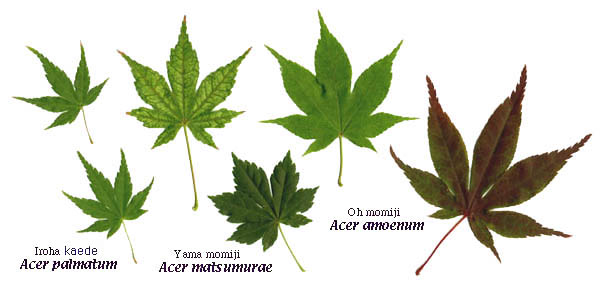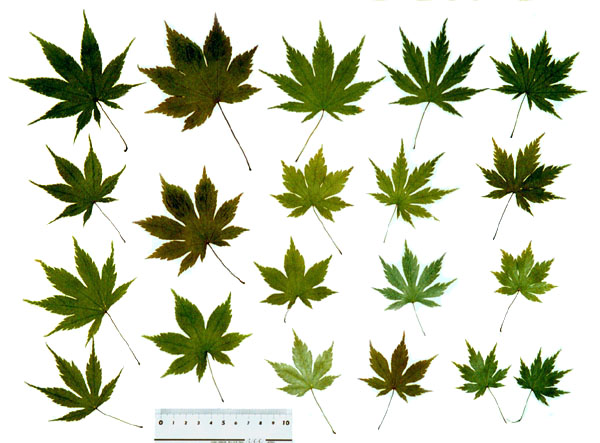
Acer palmatum and its companions which are the most familiar and are unexpectedly difficult to discern
A.palmatum, A.matsumurae, A.amoenum and their cultivars are contained in this group. Even though their cultivars are set aside, discernment of these 3 kinds is fairly difficult. That is, if 3 kinds are given as one set, relative comparison is comparatively easy. But it seems to be difficult for us in case of absolute comparison, that is, to identify what species it is when given only one leaf among 3 kinds. There really seem to be about 4 kinds of methods according to scholars on how to classify. We amateur would like to know why or how he judged them so. Let me show you some viewpoints for your information.
1. A view which regards 3 species as an independent one, respectively
2. A view which divides into two species, A.palmatum and A.amoenum, then regards A.matsumurae as subspecies of A.amoenum
3. A view which makes A.palmatum represent these 3 kinds, then regard them as its subspecies or variety
4. A view which regards A.matsumurae as the base for these 3 kinds
It would be considered that the priority of basic factors for discernment differs according to scholars. I think there should be a standardized viewpoint at least in Japan also looking at it from foreign countries, even though there are some different points of view on classification of maples. Putting ourselves in maple's place, our arguments on classification might be unwelcome favor. My American friends they usually call these 3kinds "Japanese maples" all-inclusively.
Those maples are close to these 3 kinds, such as A.japonicum, A.sieboldianum, A.shirasawanum and A.tenuifolium.

Anyway, for the better species discernment it should be generally considered that an approach from recognition both by senses and by analysis is required, and that ecological observation is the base of those.
Here, let me show you observation points for discernment of 3 kinds.
Observation points for discernment of A.palmatum, A.matsumurae and A.amoenum
lobe base narrower |
lobe base narrower |
||
infructescence |
tend to stand upright |
hang down |
hang down |
open horizontally |
slantin a wide angle |
in a wide angle |
From above, it may be said as follows; 1. When having incised subduplicate serration, they are ascerned as A.palmatum or A.matsumurae. When having nearly simple serration, discerned as A.amoenum.
2. A.matumurae is generally considered as different from A.palmatum in those factors, such as larger leaves, longer petioles, more lobes and larger samaras. Moreover, in the direction of infructescence up or down and in the angle between samaras.
According to Ogata Ken "A Dendrological Study on the Japanese Aceraceae, with Special Reference to the Geographical Distribution"(1965), on A.matsumurae, the border of the distribution area runs approximately on the line linking Mt. Iwate (Iwate Pref.), -------, ending in the central part of Fukui Pref(at the Japan Sea side). In these region, A.palmatum or A.amoenum could not be found. Except in the region where A.matsumurae is distributed, A.amoenum is distributed almost all over Japan from Hokkaido to Kyushu. A.palmatum is distributed at the Pacific side south of Fukushima Pref.
Except trees planted by hand, this form of distribution might be an effective key for the discernment of these 3 species.


Maples & Japanese maples : Species discernment